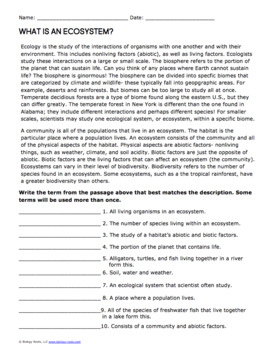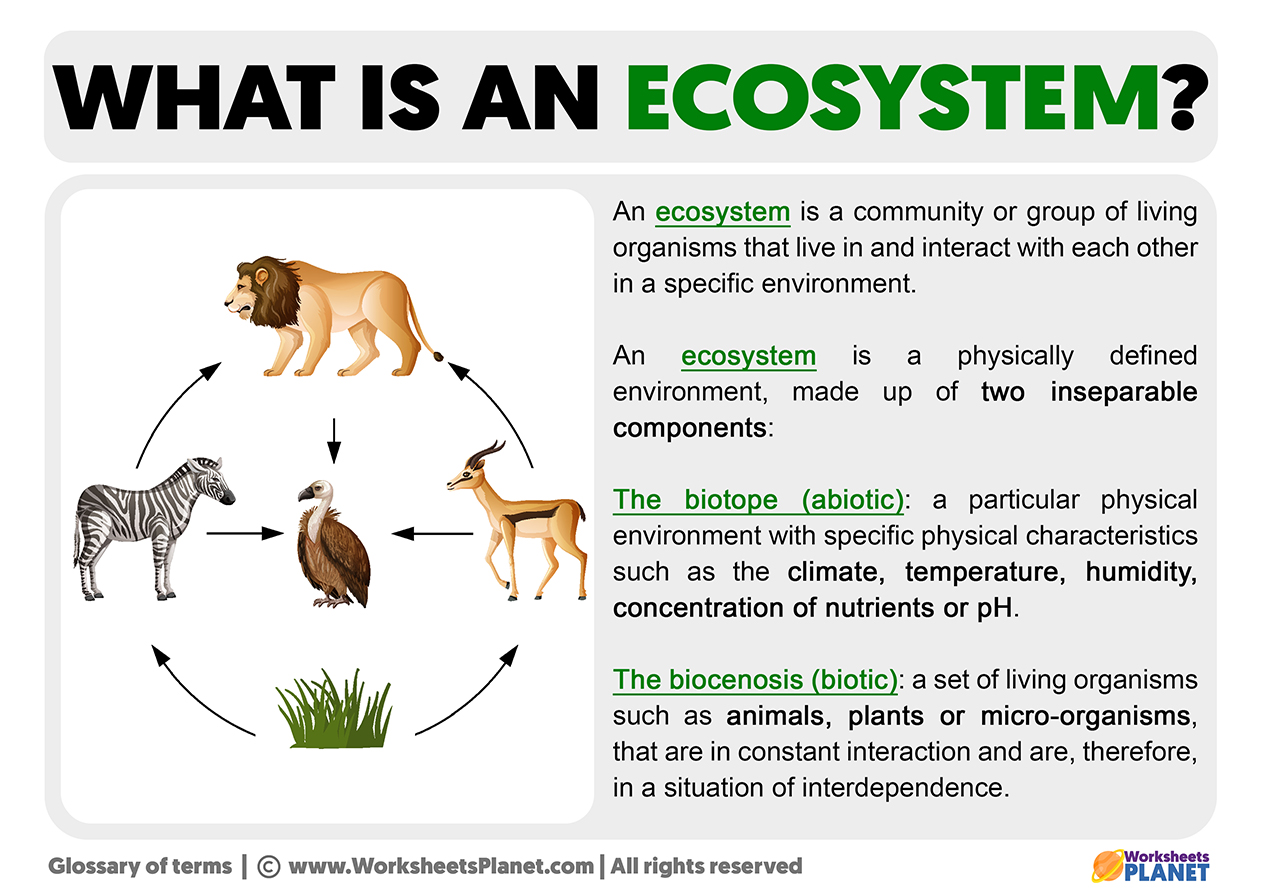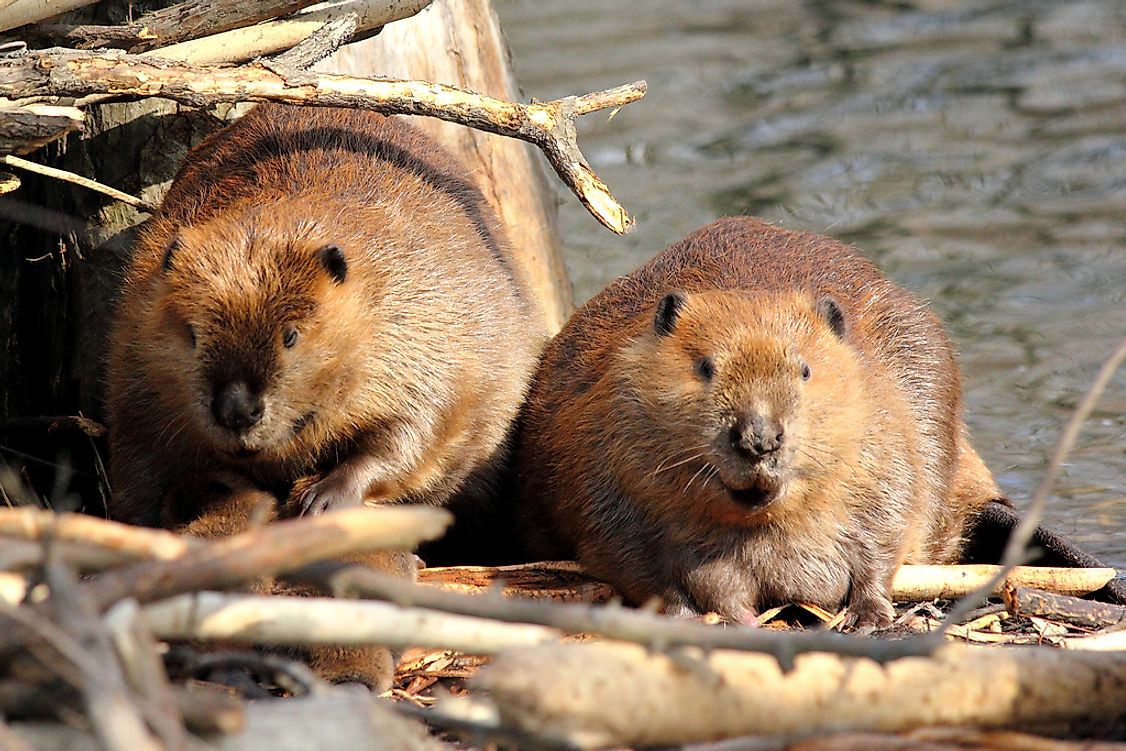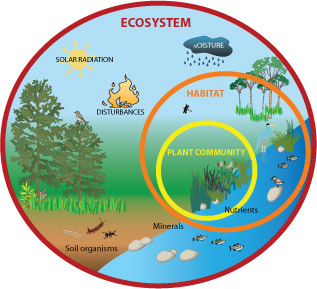Topic definition of ecosystem in science: Discover the essence of ecosystems in science: intricate networks where life intertwines with the environment, shaping our planet"s biodiversity and sustainability.
Table of Content
- What is the definition of ecosystem in science?
- What is an Ecosystem?
- Components of an Ecosystem: Biotic and Abiotic Factors
- Types of Ecosystems: Terrestrial and Aquatic
- The Structure of Ecosystems: Energy Flow and Nutrient Cycles
- Importance of Ecosystems: Biodiversity and Human Impact
- YOUTUBE: What Is An Ecosystem?
- Conservation of Ecosystems: Challenges and Strategies
- Case Studies: Examples of Ecosystem Dynamics and Restoration Efforts
- Future of Ecosystems: Climate Change and Sustainability
- Interactive Components: Engaging with Ecosystem Science
- Further Reading and Resources on Ecosystem Science
What is the definition of ecosystem in science?
An ecosystem in science is defined as:
- A complex system that consists of all the living organisms, their interactions with each other, and with the non-living components of their environment
- It includes plants, animals, microorganisms, soil, rocks, water, air, and sunlight
- The interactions within an ecosystem involve energy flow, nutrient cycling, and biological processes that maintain the balance and sustainability of the system
- Ecosystems can vary in size from small areas like a pond to large-scale regions like a forest or a marine ecosystem
- Understanding ecosystems is crucial in ecological studies and environmental conservation efforts
READ MORE:
What is an Ecosystem?
An ecosystem is a complex network of living organisms (biotic components) and the non-living (abiotic components) elements that they interact with in their environment. This interaction forms a self-regulating system that ensures the survival, growth, and reproduction of the organisms within it. Ecosystems can vary greatly in size and can be as large as a desert or as small as a puddle.
- Biotic Components: These include all the living organisms, such as plants, animals, fungi, and microorganisms.
- Abiotic Components: These encompass all the non-living elements like water, air, soil, and sunlight, which provide the essential nutrients and energy for life.
Ecosystems are categorized based on their environment and the living organisms they contain. The two main types of ecosystems are:
- Terrestrial Ecosystems: These are found on land and include forests, grasslands, deserts, and tundra.
- Aquatic Ecosystems: These exist in water environments and are classified as freshwater (lakes and rivers) or marine (oceans and coral reefs).
Each ecosystem plays a critical role in the biosphere, contributing to the planet"s health and the well-being of humanity. They provide essential services such as air and water purification, climate regulation, and the production of food, fuel, and fiber. Understanding ecosystems and their functions is vital for promoting biodiversity conservation and sustainable living practices.

Components of an Ecosystem: Biotic and Abiotic Factors
An ecosystem is comprised of two main components: biotic and abiotic factors, both of which are essential for the survival and functioning of the ecosystem. These components interact in complex ways to create a balanced and self-sustaining environment.
- Biotic Factors: These are the living components of an ecosystem and include all organisms such as plants, animals, fungi, and microorganisms. Each organism has a specific role, or niche, within the ecosystem, contributing to the overall biodiversity and health of the environment.
- Abiotic Factors: These are the non-living physical and chemical elements that affect the ability of organisms to survive and reproduce. Abiotic factors include sunlight, temperature, water, atmospheric gases, wind, soil, and mineral nutrients. They determine the types of organisms that can thrive in an ecosystem and how abundant they will be.
Interactions between biotic and abiotic factors are fundamental to the study of ecology. These interactions can be:
- Energy Flow: Sunlight is converted into usable energy by plants through photosynthesis, which then passes through the ecosystem via the food chain.
- Nutrient Cycling: Nutrients are recycled in the ecosystem through processes like decomposition, allowing for the continuous support of life.
The balance between these components is crucial for ecosystem health. Changes in abiotic factors can have significant impacts on the ecosystem, leading to shifts in the biotic community and overall ecosystem dynamics. Understanding these components and their interactions is key to managing and conserving ecosystems effectively.
Types of Ecosystems: Terrestrial and Aquatic
Ecosystems are broadly categorized into two types based on their environment: terrestrial and aquatic. Each type hosts unique biotic and abiotic components, creating diverse habitats for various species.
- Terrestrial Ecosystems: These ecosystems are found on land and are characterized by the type of vegetation present, which is largely influenced by climate. Major types of terrestrial ecosystems include:
- Forests: Including tropical rainforests, temperate forests, and boreal forests.
- Grasslands: Including savannas, prairies, and steppes.
- Deserts: Characterized by dry conditions and sparse vegetation.
- Tundra: Found in the arctic regions, characterized by cold temperatures and short growing seasons.
- Aquatic Ecosystems: These ecosystems are located in bodies of water and are classified into two main types:
- Freshwater Ecosystems: Including rivers, lakes, streams, and wetlands. These ecosystems are characterized by low salt content.
- Marine Ecosystems: Including oceans, coral reefs, and estuaries. These ecosystems have a high salt content and cover about 70% of the Earth"s surface.
Each type of ecosystem supports unique species adapted to their environments. Terrestrial ecosystems are critical for providing habitat, food, and other resources for land-dwelling species. Aquatic ecosystems play a vital role in regulating the global climate, supporting marine life, and providing resources such as fish that are essential for human societies. Understanding the different types of ecosystems and their characteristics is fundamental to the study of ecology and the conservation of biodiversity.
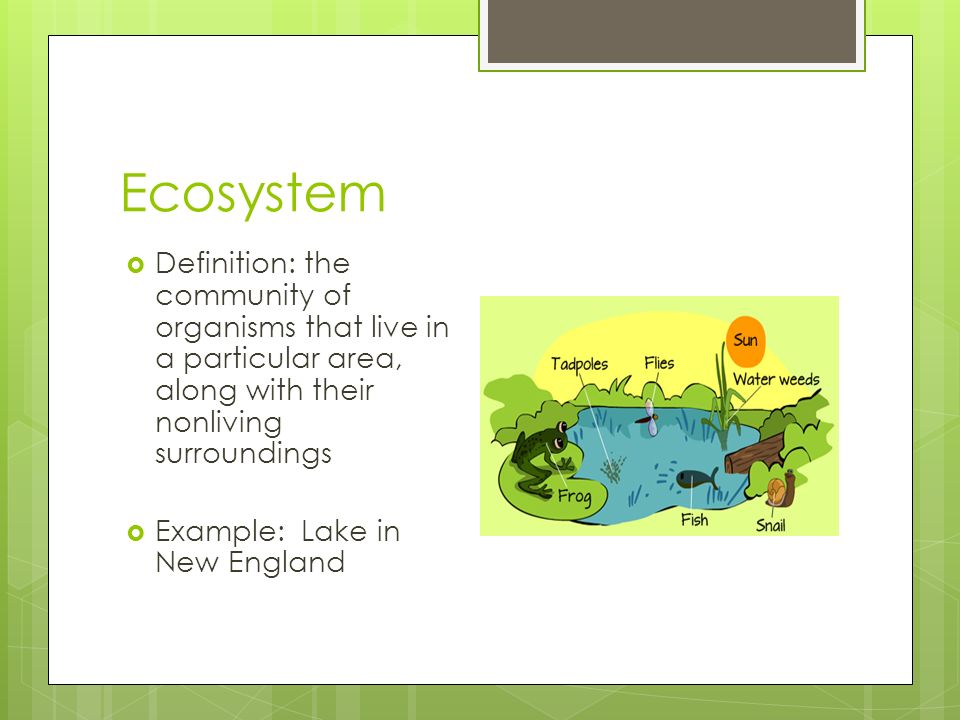
The Structure of Ecosystems: Energy Flow and Nutrient Cycles
The structure of ecosystems is defined by the flow of energy and the cycling of nutrients, which are crucial processes that sustain life. Energy flows through an ecosystem in one direction, from the sun to producers and then to consumers, while nutrients recycle within the ecosystem, supporting various life forms.
- Energy Flow: Energy enters an ecosystem through sunlight, which is captured by producers (primarily plants) through photosynthesis. This energy is then transferred to consumers in a hierarchical manner:
- Primary Consumers (Herbivores) feed directly on producers.
- Secondary Consumers (Carnivores) feed on primary consumers.
- Tertiary Consumers feed on secondary consumers.
- Decomposers play a crucial role in breaking down dead organisms, releasing energy back into the ecosystem.
- Nutrient Cycles: Nutrients such as carbon, nitrogen, and phosphorus cycle through the ecosystem, moving between the soil, water, and atmosphere. These cycles involve several processes:
- The Carbon Cycle involves the exchange of carbon among the biosphere, pedosphere, geosphere, hydrosphere, and atmosphere of the Earth.
- The Nitrogen Cycle is the process by which nitrogen is converted into various chemical forms as it circulates among the atmosphere, terrestrial, and marine ecosystems.
- The Phosphorus Cycle involves the movement of phosphorus through the lithosphere, hydrosphere, and biosphere.
- These nutrient cycles are essential for creating the building blocks of DNA, RNA, proteins, and other compounds necessary for life.
Understanding the structure of ecosystems, including the energy flow and nutrient cycles, is vital for grasping how ecosystems function and sustain life. These processes also highlight the interconnectedness of all living organisms and their environment, emphasizing the importance of conserving and protecting our natural ecosystems.
Importance of Ecosystems: Biodiversity and Human Impact
Ecosystems play a crucial role in maintaining the planet"s health and supporting life. The diversity of life within these systems, known as biodiversity, provides invaluable services to the environment and humanity. However, human activities have significant impacts on ecosystems, highlighting the need for sustainable practices.
- Benefits of Biodiversity: Biodiversity enhances ecosystem productivity and resilience, allowing ecosystems to withstand environmental stress and providing a greater variety of species with the means to thrive. It supports ecosystem services such as:
- Pollination of crops by insects.
- Natural pest control.
- Water purification through wetlands.
- Carbon sequestration by forests.
- Human Impact: Human activities, including deforestation, pollution, overfishing, and climate change, have profound effects on ecosystems. These impacts can lead to:
- Loss of biodiversity.
- Alteration of natural habitats.
- Disruption of nutrient cycles and energy flow.
- Decreased ecosystem services.
- Addressing these challenges requires global cooperation and sustainable management of natural resources.
The importance of ecosystems extends beyond their intrinsic value; they are essential for human survival and well-being. Preserving ecosystems and their biodiversity is not only a moral obligation but a practical necessity for maintaining the balance of the Earth"s environment and ensuring a sustainable future for all species, including humans.

What Is An Ecosystem?
Keyword: Ecosystem Explore the fascinating world of ecosystems in this video, where you will witness the diverse interactions between living organisms and their environments. Discover the delicate balance of nature and the beauty of sustainability. Keyword: Types Dive into a journey of exploration as this video showcases the various types of landscapes, animals, and plants found in different habitats. Uncover the unique characteristics and adaptations that make each type special and essential to our world.
Different Types of Ecosystem in Environmental Science
Hello Friends, Check out this video on \"What is Ecosystem? | Different types of Ecosystem\" in #Environmental Science (EVS) by ...
Conservation of Ecosystems: Challenges and Strategies
Conserving ecosystems is critical for sustaining biodiversity, ensuring natural resources for future generations, and maintaining ecological balance. However, this task faces numerous challenges that require effective strategies and collaborative efforts globally.
- Challenges in Conservation: The main obstacles include habitat destruction, climate change, pollution, invasive species, and overexploitation of natural resources. These factors threaten the survival of ecosystems and the services they provide, necessitating urgent and concerted conservation actions.
- Conservation Strategies: To address these challenges, a multifaceted approach is essential, including:
- Protected Areas: Establishing and effectively managing protected areas to conserve biodiversity hotspots and critical habitats.
- Restoration Projects: Implementing ecosystem restoration projects to rehabilitate degraded lands and waters, enhancing their ecological functionality.
- Legislation and Policy: Enforcing laws and policies that protect ecosystems, wildlife, and natural resources from exploitation and destruction.
- Community Engagement: Involving local communities in conservation efforts, recognizing their dependence on ecosystems for livelihood and cultural values.
- Scientific Research: Conducting research to better understand ecosystems, their responses to environmental changes, and the effectiveness of conservation strategies.
- Sustainable Practices: Promoting sustainable land use, agriculture, and fishing practices to reduce human impact on ecosystems.
The conservation of ecosystems is not only an environmental issue but also a societal one, requiring the integration of ecological, economic, and social considerations. By implementing these strategies, we can work towards a sustainable coexistence with our natural environment, ensuring the preservation of ecosystems for the well-being of current and future generations.
Case Studies: Examples of Ecosystem Dynamics and Restoration Efforts
Examining case studies of ecosystem dynamics and restoration offers valuable insights into the resilience of nature and the effectiveness of conservation strategies. These examples highlight the challenges and successes of restoring ecosystems and maintaining biodiversity.
- The Everglades Restoration Project, USA: A comprehensive effort to restore the natural flow of water to this unique wetland ecosystem, addressing issues such as water pollution and habitat destruction. This project demonstrates the importance of water management in ecosystem restoration.
- The Great Green Wall, Africa: An ambitious initiative to combat desertification in the Sahel region through the planting of a vast belt of trees across Africa. This project illustrates the role of afforestation in improving soil health, enhancing biodiversity, and supporting local communities.
- The Yellow River Wetland Conservation, China: Efforts to conserve and restore wetlands along the Yellow River have shown significant benefits in biodiversity conservation, flood control, and water purification, showcasing the multifunctional value of wetlands.
- The Coral Triangle Initiative, Southeast Asia: A multilateral partnership to safeguard the marine biodiversity of the Coral Triangle, addressing threats like overfishing and coral bleaching through marine protected areas, sustainable fisheries, and community-based conservation.
These case studies underscore the complexity of ecosystem dynamics and the need for integrated, adaptive management approaches to conservation and restoration. They serve as inspiring examples of how concerted efforts can lead to meaningful ecological recovery and sustainability.

Future of Ecosystems: Climate Change and Sustainability
The future of ecosystems in the face of climate change and the pursuit of sustainability is a critical concern for scientists, policymakers, and the global community. The impacts of climate change are far-reaching, affecting biodiversity, ecosystem services, and human well-being. However, through sustainable practices and mitigation strategies, there is potential for positive outcomes.
- Impact of Climate Change: Climate change is altering ecosystems worldwide, leading to shifts in species distributions, changes in phenology, and increased vulnerability to invasive species. These changes threaten the balance and functionality of ecosystems, with implications for the services they provide.
- Sustainability Efforts: Addressing the challenges posed by climate change requires a commitment to sustainability. This involves:
- Reducing greenhouse gas emissions through cleaner energy sources.
- Implementing conservation strategies to protect biodiversity.
- Adopting sustainable land-use practices that minimize environmental impact.
- Enhancing ecosystem resilience through restoration efforts.
- Adaptive Management: Adaptive management strategies are essential for responding to the dynamic nature of ecosystems under changing climate conditions. This approach involves monitoring, learning from past management outcomes, and adjusting strategies as necessary to achieve conservation and sustainability goals.
The future of ecosystems hinges on our ability to mitigate the impacts of climate change and embrace sustainability in our actions. By fostering resilience and adaptive capacity in ecosystems, we can safeguard biodiversity and ensure the continued provision of vital ecosystem services for future generations.
Interactive Components: Engaging with Ecosystem Science
Engaging with ecosystem science through interactive components can greatly enhance understanding and awareness of ecological concepts and conservation efforts. These tools and platforms allow individuals to explore, learn, and contribute to the field of ecology in dynamic and impactful ways.
- Virtual Reality (VR) and Augmented Reality (AR): VR and AR applications can simulate ecosystem dynamics and provide immersive experiences that highlight the complexity and beauty of natural environments, fostering a deeper connection and understanding.
- Citizen Science Projects: These projects involve the public in scientific research, allowing individuals to contribute data on biodiversity, species distribution, and environmental changes, which can be crucial for ecological studies and conservation efforts.
- Educational Games and Simulations: Interactive games and simulations that model ecosystem processes and human impacts can educate users on the importance of ecosystems and the consequences of environmental decisions.
- Online Courses and Workshops: Offering accessible and comprehensive learning opportunities about ecosystem science and conservation strategies can empower individuals with the knowledge to support sustainability efforts.
- Interactive Maps and Data Visualization: Tools that visualize scientific data on ecosystems, such as species distribution maps and climate change models, can make complex information understandable and engaging for a wide audience.
By leveraging these interactive components, ecosystem science can reach a broader audience, encouraging active participation in conservation and sustainability efforts. These experiences not only educate but also inspire action towards preserving the delicate balance of our planet"s ecosystems.

READ MORE:
Further Reading and Resources on Ecosystem Science
To deepen your understanding of ecosystem science and explore the latest research, conservation strategies, and educational materials, a wealth of resources is available. These resources can provide valuable insights into the complexities of ecosystems and the efforts being made to protect them.
- Scientific Journals: Journals such as "Ecology," "Conservation Biology," and "Ecosystem Services" publish peer-reviewed research on ecosystem dynamics, biodiversity, and the effects of human activities on natural environments.
- Books: There are numerous informative books on ecology and ecosystem science, including textbooks for academic study and accessible works for general readers interested in environmental science.
- Websites and Online Portals: Websites like the National Geographic and the Nature Conservancy offer extensive articles, photo essays, and videos on ecosystems around the world, highlighting both the beauty and the challenges they face.
- Documentaries and Films: Documentaries such as "Planet Earth" and "Our Planet" provide visually stunning insights into ecosystems across the globe, showcasing the diversity of life and the environmental issues impacting these habitats.
- Educational Organizations: Organizations like the Ecological Society of America and the International Union for Conservation of Nature (IUCN) offer resources for educators, students, and professionals, including workshops, conferences, and conservation projects.
Engaging with these resources can enhance your understanding of ecosystem science, spur interest in environmental stewardship, and inspire action towards sustainable living and conservation efforts.
Exploring the definition of ecosystem in science unveils a world where every element interconnects, highlighting our role in nurturing this balance for a sustainable future. Let"s cherish and protect our planet"s vital ecosystems together.


